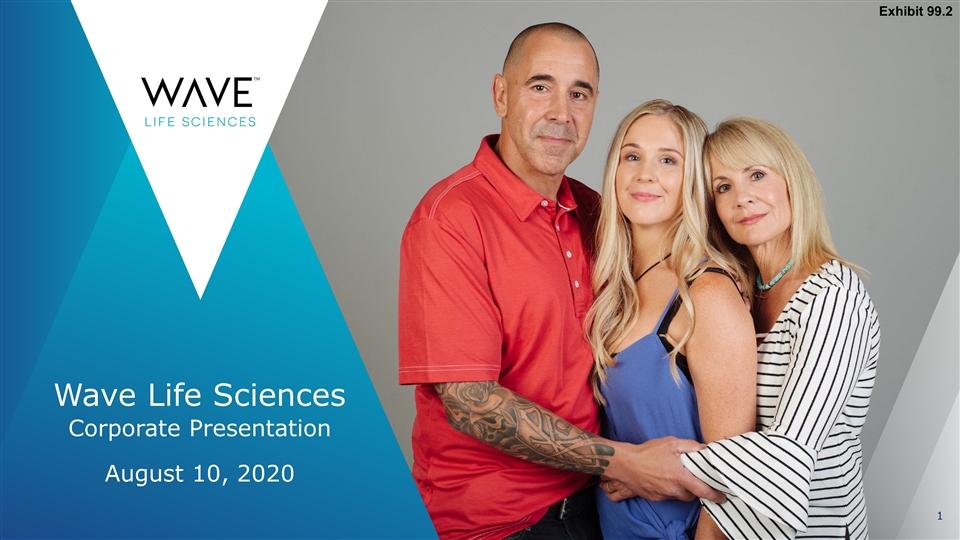
Wave Life Sciences Corporate Presentation August 10, 2020 Exhibit 99.2
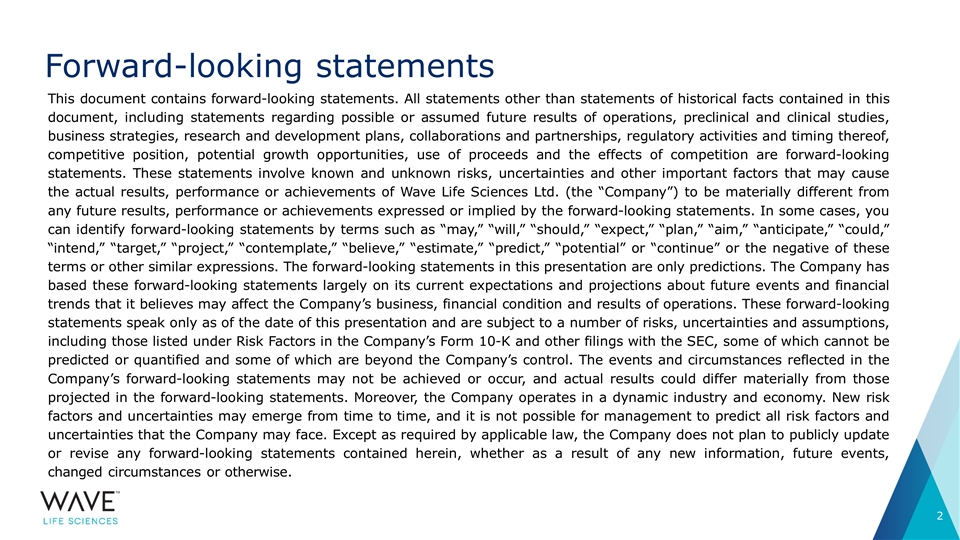
Forward-looking statements This document contains forward-looking statements. All statements other than statements of historical facts contained in this document, including statements regarding possible or assumed future results of operations, preclinical and clinical studies, business strategies, research and development plans, collaborations and partnerships, regulatory activities and timing thereof, competitive position, potential growth opportunities, use of proceeds and the effects of competition are forward-looking statements. These statements involve known and unknown risks, uncertainties and other important factors that may cause the actual results, performance or achievements of Wave Life Sciences Ltd. (the “Company”) to be materially different from any future results, performance or achievements expressed or implied by the forward-looking statements. In some cases, you can identify forward-looking statements by terms such as “may,” “will,” “should,” “expect,” “plan,” “aim,” “anticipate,” “could,” “intend,” “target,” “project,” “contemplate,” “believe,” “estimate,” “predict,” “potential” or “continue” or the negative of these terms or other similar expressions. The forward-looking statements in this presentation are only predictions. The Company has based these forward-looking statements largely on its current expectations and projections about future events and financial trends that it believes may affect the Company’s business, financial condition and results of operations. These forward-looking statements speak only as of the date of this presentation and are subject to a number of risks, uncertainties and assumptions, including those listed under Risk Factors in the Company’s Form 10-K and other filings with the SEC, some of which cannot be predicted or quantified and some of which are beyond the Company’s control. The events and circumstances reflected in the Company’s forward-looking statements may not be achieved or occur, and actual results could differ materially from those projected in the forward-looking statements. Moreover, the Company operates in a dynamic industry and economy. New risk factors and uncertainties may emerge from time to time, and it is not possible for management to predict all risk factors and uncertainties that the Company may face. Except as required by applicable law, the Company does not plan to publicly update or revise any forward-looking statements contained herein, whether as a result of any new information, future events, changed circumstances or otherwise.
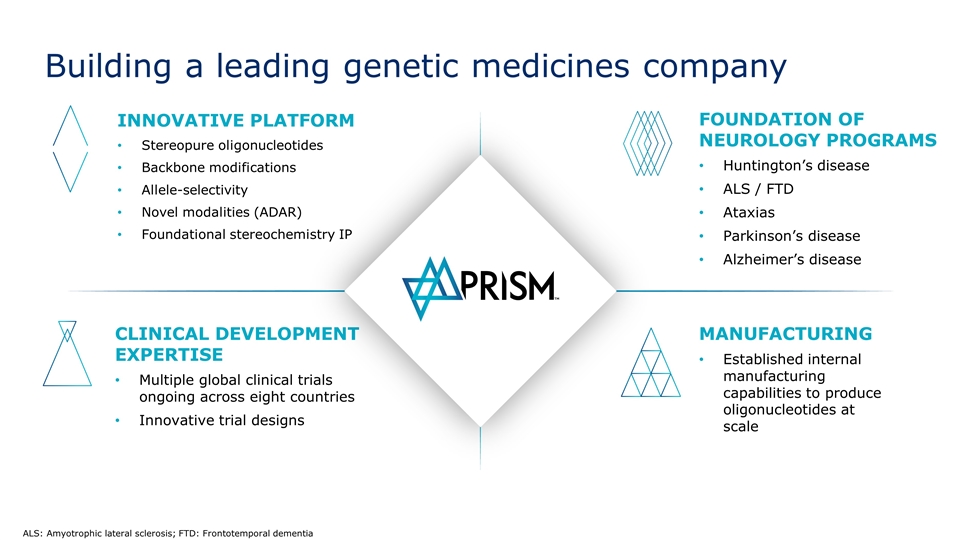
Building a leading genetic medicines company Innovative platform Stereopure oligonucleotides Backbone modifications Allele-selectivity Novel modalities (ADAR) Foundational stereochemistry IP Foundation of NEUROLOGY programs Huntington’s disease ALS / FTD Ataxias Parkinson’s disease Alzheimer’s disease Clinical development expertise Multiple global clinical trials ongoing across eight countries Innovative trial designs Manufacturing Established internal manufacturing capabilities to produce oligonucleotides at scale Cash runway into 3Q 2021, including expected and committed cash from collaborations ALS: Amyotrophic lateral sclerosis; FTD: Frontotemporal dementia
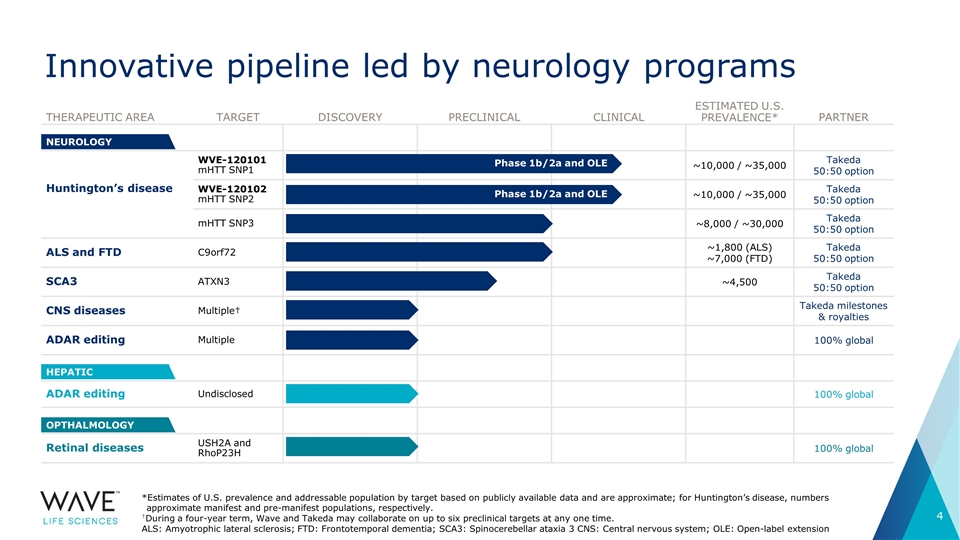
THERAPEUTIC AREA TARGET DISCOVERY PRECLINICAL CLINICAL ESTIMATED U.S. PREVALENCE* PARTNER Huntington’s disease WVE-120101 mHTT SNP1 ~10,000 / ~35,000 Takeda 50:50 option WVE-120102 mHTT SNP2 ~10,000 / ~35,000 Takeda 50:50 option mHTT SNP3 ~8,000 / ~30,000 Takeda 50:50 option ALS and FTD C9orf72 ~1,800 (ALS) ~7,000 (FTD) Takeda 50:50 option SCA3 ATXN3 ~4,500 Takeda 50:50 option CNS diseases Multiple† Takeda milestones & royalties ADAR editing Multiple 100% global ADAR editing Undisclosed 100% global Retinal diseases USH2A and RhoP23H 100% global NEUROLOGY HEPATIC OPTHALMOLOGY Phase 1b/2a and OLE Phase 1b/2a and OLE Innovative pipeline led by neurology programs *Estimates of U.S. prevalence and addressable population by target based on publicly available data and are approximate; for Huntington’s disease, numbers approximate manifest and pre-manifest populations, respectively. †During a four-year term, Wave and Takeda may collaborate on up to six preclinical targets at any one time. ALS: Amyotrophic lateral sclerosis; FTD: Frontotemporal dementia; SCA3: Spinocerebellar ataxia 3 CNS: Central nervous system; OLE: Open-label extension
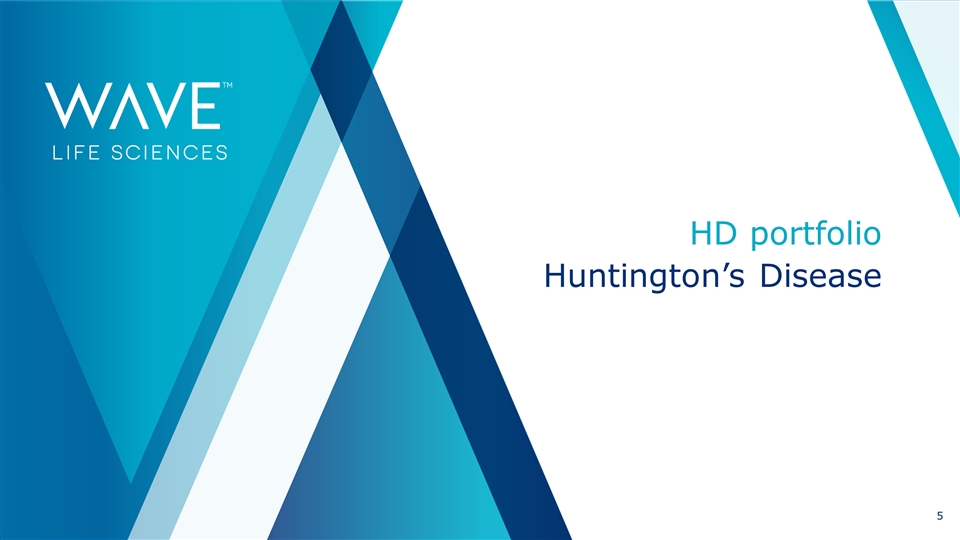
HD portfolio Huntington’s Disease
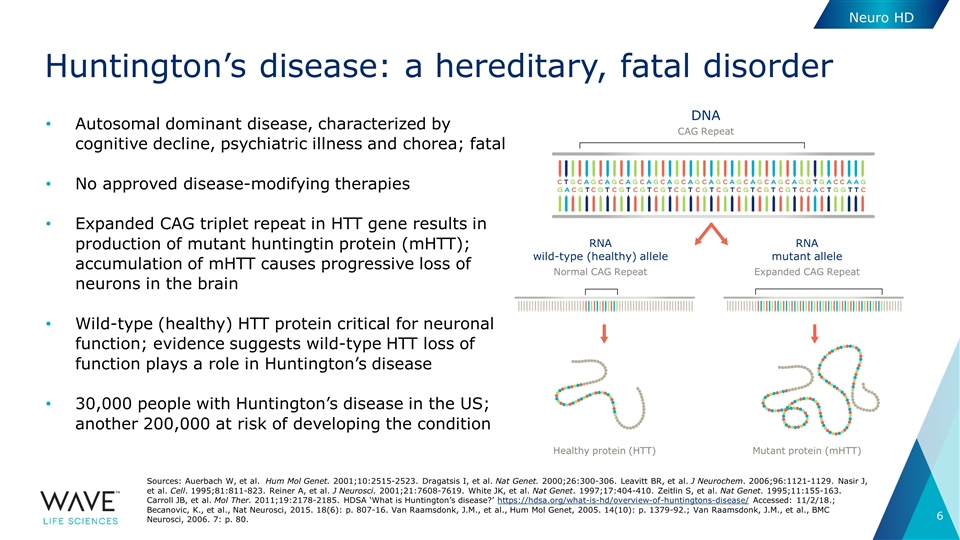
Huntington’s disease: a hereditary, fatal disorder Sources: Auerbach W, et al. Hum Mol Genet. 2001;10:2515-2523. Dragatsis I, et al. Nat Genet. 2000;26:300-306. Leavitt BR, et al. J Neurochem. 2006;96:1121-1129. Nasir J, et al. Cell. 1995;81:811-823. Reiner A, et al. J Neurosci. 2001;21:7608-7619. White JK, et al. Nat Genet. 1997;17:404-410. Zeitlin S, et al. Nat Genet. 1995;11:155-163. Carroll JB, et al. Mol Ther. 2011;19:2178-2185. HDSA ‘What is Huntington’s disease?’ https://hdsa.org/what-is-hd/overview-of-huntingtons-disease/ Accessed: 11/2/18.; Becanovic, K., et al., Nat Neurosci, 2015. 18(6): p. 807-16. Van Raamsdonk, J.M., et al., Hum Mol Genet, 2005. 14(10): p. 1379-92.; Van Raamsdonk, J.M., et al., BMC Neurosci, 2006. 7: p. 80. DNA CAG Repeat RNA wild-type (healthy) allele RNA mutant allele Normal CAG Repeat Expanded CAG Repeat Healthy protein (HTT) Mutant protein (mHTT) Neuro HD Autosomal dominant disease, characterized by cognitive decline, psychiatric illness and chorea; fatal No approved disease-modifying therapies Expanded CAG triplet repeat in HTT gene results in production of mutant huntingtin protein (mHTT); accumulation of mHTT causes progressive loss of neurons in the brain Wild-type (healthy) HTT protein critical for neuronal function; evidence suggests wild-type HTT loss of function plays a role in Huntington’s disease 30,000 people with Huntington’s disease in the US; another 200,000 at risk of developing the condition
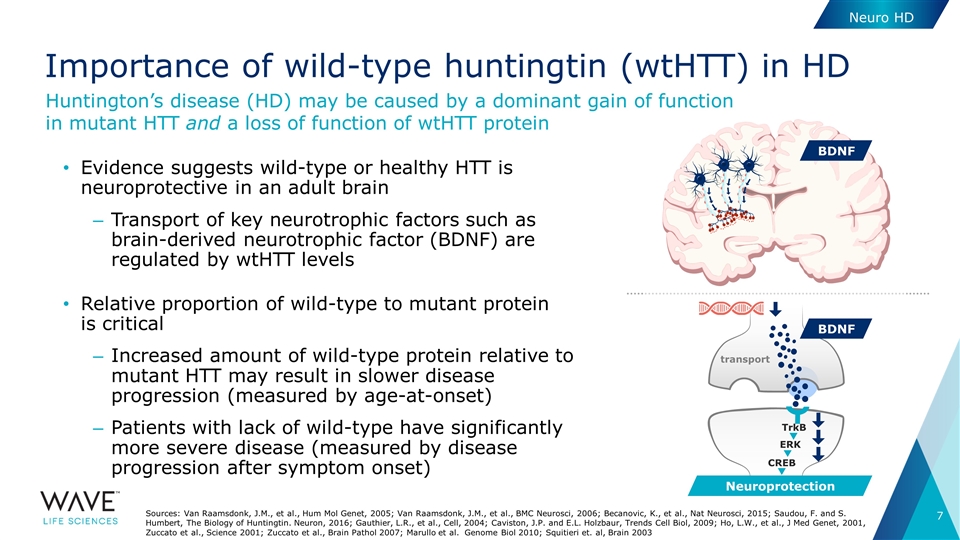
Evidence suggests wild-type or healthy HTT is neuroprotective in an adult brain Transport of key neurotrophic factors such as brain-derived neurotrophic factor (BDNF) are regulated by wtHTT levels Relative proportion of wild-type to mutant protein is critical Increased amount of wild-type protein relative to mutant HTT may result in slower disease progression (measured by age-at-onset) Patients with lack of wild-type have significantly more severe disease (measured by disease progression after symptom onset) Importance of wild-type huntingtin (wtHTT) in HD Neuro HD Huntington’s disease (HD) may be caused by a dominant gain of function in mutant HTT and a loss of function of wtHTT protein Sources: Van Raamsdonk, J.M., et al., Hum Mol Genet, 2005; Van Raamsdonk, J.M., et al., BMC Neurosci, 2006; Becanovic, K., et al., Nat Neurosci, 2015; Saudou, F. and S. Humbert, The Biology of Huntingtin. Neuron, 2016; Gauthier, L.R., et al., Cell, 2004; Caviston, J.P. and E.L. Holzbaur, Trends Cell Biol, 2009; Ho, L.W., et al., J Med Genet, 2001, Zuccato et al., Science 2001; Zuccato et al., Brain Pathol 2007; Marullo et al. Genome Biol 2010; Squitieri et. al, Brain 2003 BDNF TrkB ERK CREB transport BDNF Neuroprotection
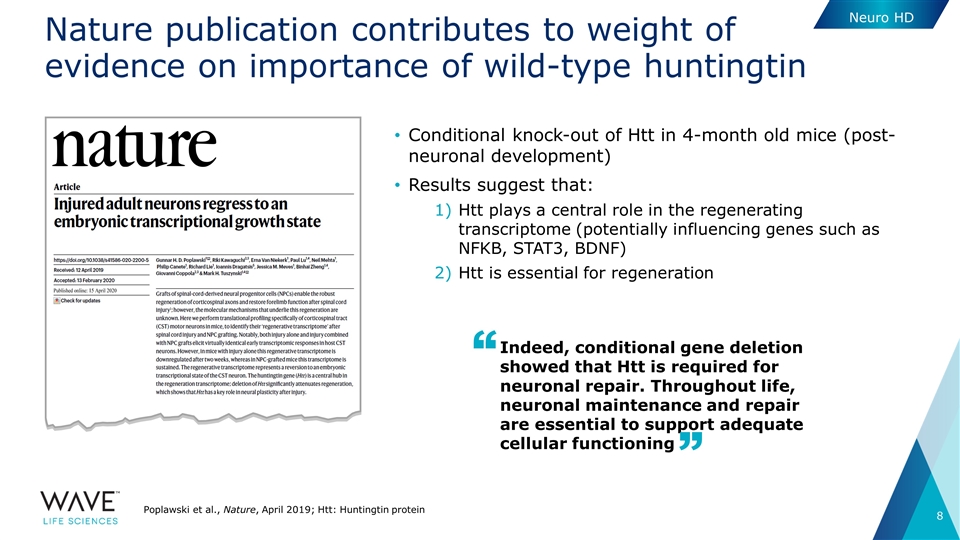
Nature publication contributes to weight of evidence on importance of wild-type huntingtin Poplawski et al., Nature, April 2019; Htt: Huntingtin protein Conditional knock-out of Htt in 4-month old mice (post-neuronal development) Results suggest that: Htt plays a central role in the regenerating transcriptome (potentially influencing genes such as NFKB, STAT3, BDNF) Htt is essential for regeneration Indeed, conditional gene deletion showed that Htt is required for neuronal repair. Throughout life, neuronal maintenance and repair are essential to support adequate cellular functioning Neuro HD
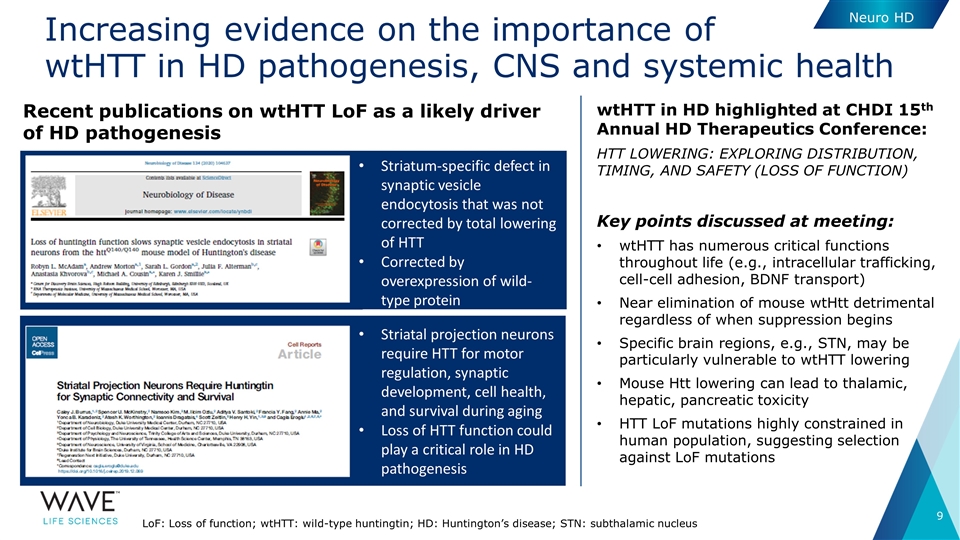
Increasing evidence on the importance of wtHTT in HD pathogenesis, CNS and systemic health Striatum-specific defect in synaptic vesicle endocytosis that was not corrected by total lowering of HTT Corrected by overexpression of wild-type protein Striatal projection neurons require HTT for motor regulation, synaptic development, cell health, and survival during aging Loss of HTT function could play a critical role in HD pathogenesis wtHTT in HD highlighted at CHDI 15th Annual HD Therapeutics Conference: HTT LOWERING: EXPLORING DISTRIBUTION, TIMING, AND SAFETY (LOSS OF FUNCTION) Key points discussed at meeting: wtHTT has numerous critical functions throughout life (e.g., intracellular trafficking, cell-cell adhesion, BDNF transport) Near elimination of mouse wtHtt detrimental regardless of when suppression begins Specific brain regions, e.g., STN, may be particularly vulnerable to wtHTT lowering Mouse Htt lowering can lead to thalamic, hepatic, pancreatic toxicity HTT LoF mutations highly constrained in human population, suggesting selection against LoF mutations Recent publications on wtHTT LoF as a likely driver of HD pathogenesis LoF: Loss of function; wtHTT: wild-type huntingtin; HD: Huntington’s disease; STN: subthalamic nucleus Neuro HD
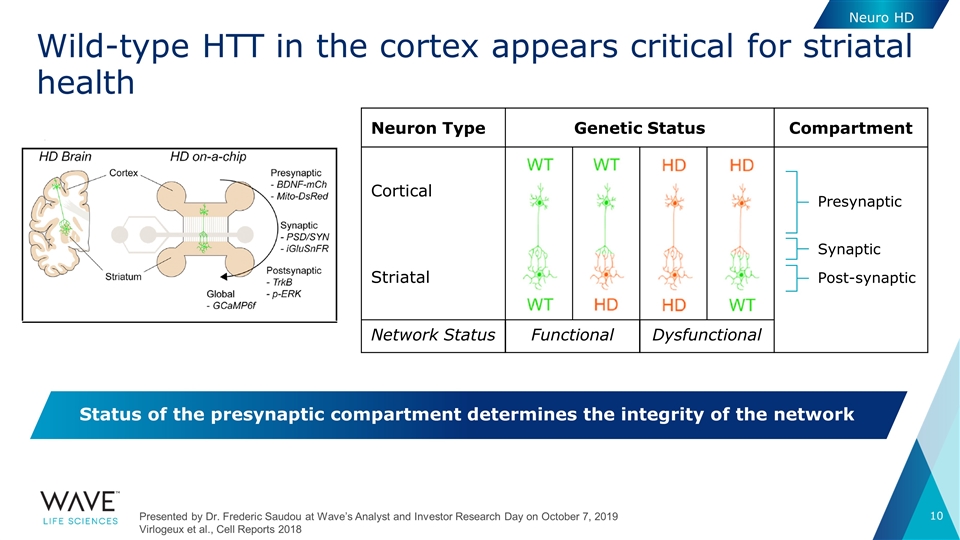
Wild-type HTT in the cortex appears critical for striatal health Presented by Dr. Frederic Saudou at Wave’s Analyst and Investor Research Day on October 7, 2019 Virlogeux et al., Cell Reports 2018 Neuro HD Neuron Type Genetic Status Compartment Cortical Striatal Network Status Functional Dysfunctional Post-synaptic Synaptic Presynaptic Status of the presynaptic compartment determines the integrity of the network
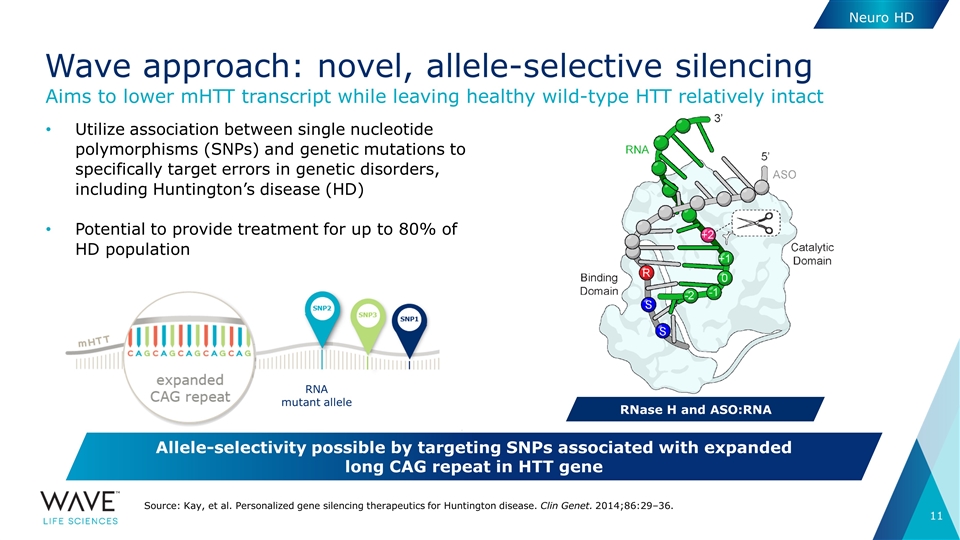
Utilize association between single nucleotide polymorphisms (SNPs) and genetic mutations to specifically target errors in genetic disorders, including Huntington’s disease (HD) Potential to provide treatment for up to 80% of HD population Wave approach: novel, allele-selective silencing Source: Kay, et al. Personalized gene silencing therapeutics for Huntington disease. Clin Genet. 2014;86:29–36. Neuro HD Aims to lower mHTT transcript while leaving healthy wild-type HTT relatively intact Allele-selectivity possible by targeting SNPs associated with expanded long CAG repeat in HTT gene RNase H and ASO:RNA RNA mutant allele
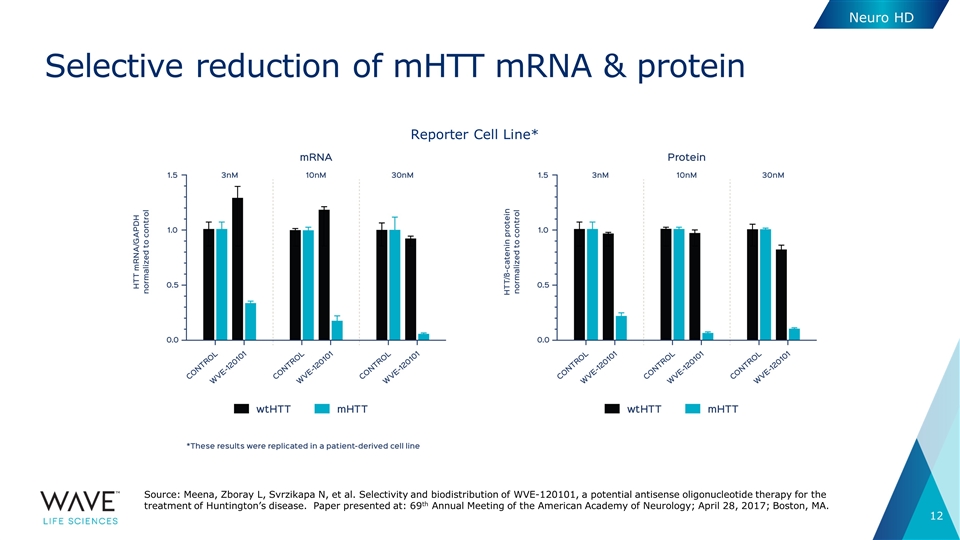
Selective reduction of mHTT mRNA & protein Reporter Cell Line* Neuro HD Source: Meena, Zboray L, Svrzikapa N, et al. Selectivity and biodistribution of WVE-120101, a potential antisense oligonucleotide therapy for the treatment of Huntington’s disease. Paper presented at: 69th Annual Meeting of the American Academy of Neurology; April 28, 2017; Boston, MA.
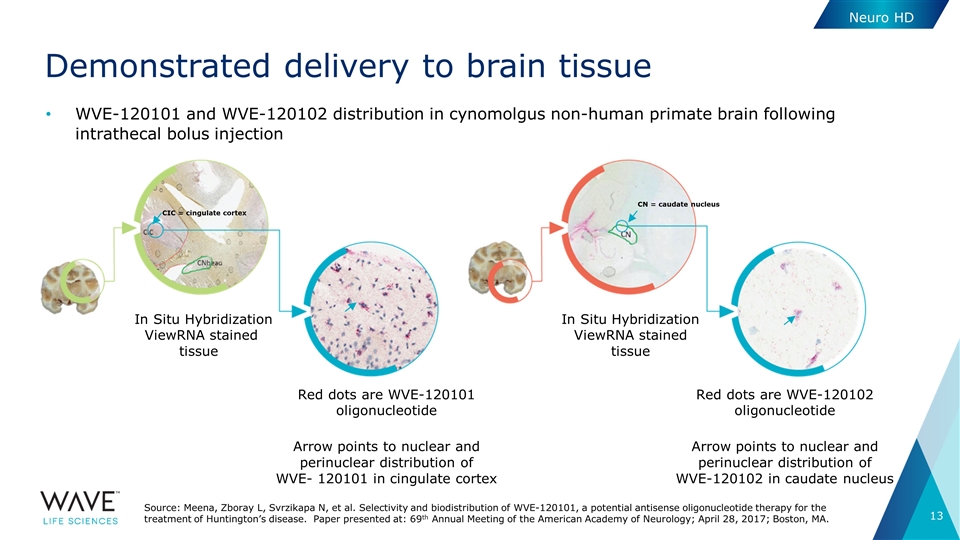
Demonstrated delivery to brain tissue WVE-120101 and WVE-120102 distribution in cynomolgus non-human primate brain following intrathecal bolus injection In Situ Hybridization ViewRNA stained tissue Red dots are WVE-120102 oligonucleotide Arrow points to nuclear and perinuclear distribution of WVE-120102 in caudate nucleus Red dots are WVE-120101 oligonucleotide Arrow points to nuclear and perinuclear distribution of WVE- 120101 in cingulate cortex CIC = cingulate cortex In Situ Hybridization ViewRNA stained tissue Neuro HD CN = caudate nucleus Source: Meena, Zboray L, Svrzikapa N, et al. Selectivity and biodistribution of WVE-120101, a potential antisense oligonucleotide therapy for the treatment of Huntington’s disease. Paper presented at: 69th Annual Meeting of the American Academy of Neurology; April 28, 2017; Boston, MA.
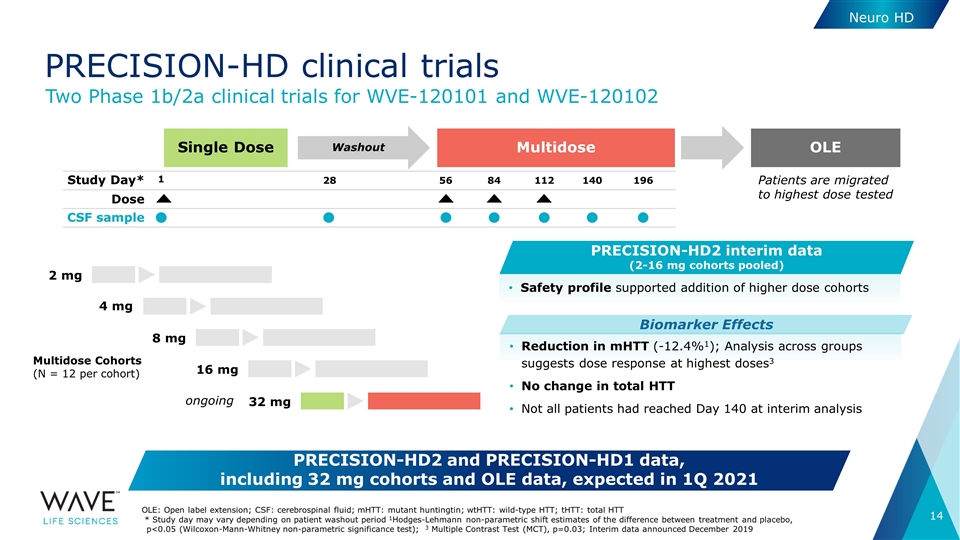
Safety profile supported addition of higher dose cohorts PRECISION-HD clinical trials Single Dose Multidose 196 1 Washout CSF sample Dose 28 56 84 112 Study Day* 140 OLE 2 mg 4 mg 8 mg 16 mg 32 mg PRECISION-HD2 and PRECISION-HD1 data, including 32 mg cohorts and OLE data, expected in 1Q 2021 Multidose Cohorts (N = 12 per cohort) PRECISION-HD2 interim data (2-16 mg cohorts pooled) OLE: Open label extension; CSF: cerebrospinal fluid; mHTT: mutant huntingtin; wtHTT: wild-type HTT; tHTT: total HTT * Study day may vary depending on patient washout period 1Hodges-Lehmann non-parametric shift estimates of the difference between treatment and placebo, p<0.05 (Wilcoxon-Mann-Whitney non-parametric significance test); 3 Multiple Contrast Test (MCT), p=0.03; Interim data announced December 2019 Biomarker Effects Two Phase 1b/2a clinical trials for WVE-120101 and WVE-120102 ongoing Patients are migrated to highest dose tested Reduction in mHTT (-12.4%1); Analysis across groups suggests dose response at highest doses3 No change in total HTT Not all patients had reached Day 140 at interim analysis Neuro HD
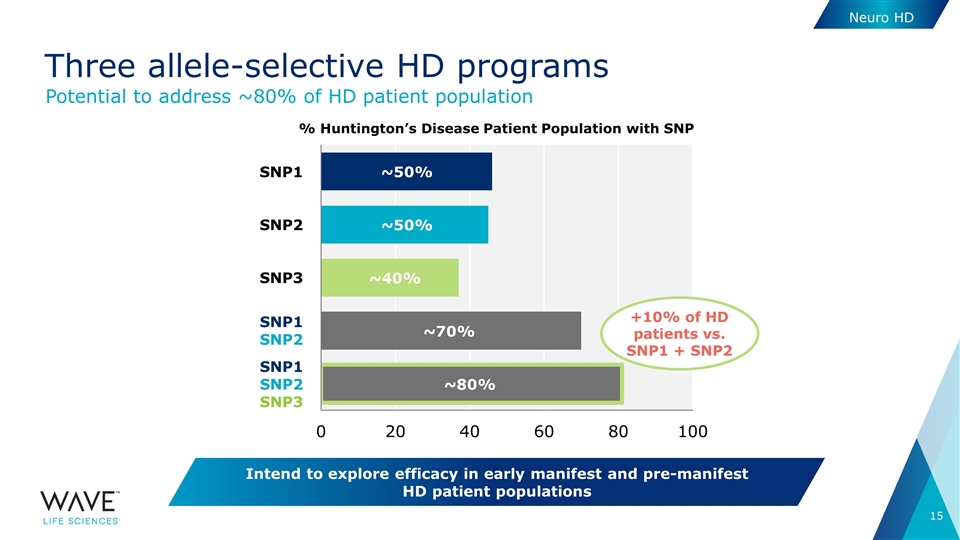
Three allele-selective HD programs Intend to explore efficacy in early manifest and pre-manifest HD patient populations Neuro HD Potential to address ~80% of HD patient population % Huntington’s Disease Patient Population with SNP SNP1 SNP2 SNP3 SNP1 SNP2 SNP1 SNP2 SNP3 ~50% ~50% ~40% ~70% ~80% +10% of HD patients vs. SNP1 + SNP2
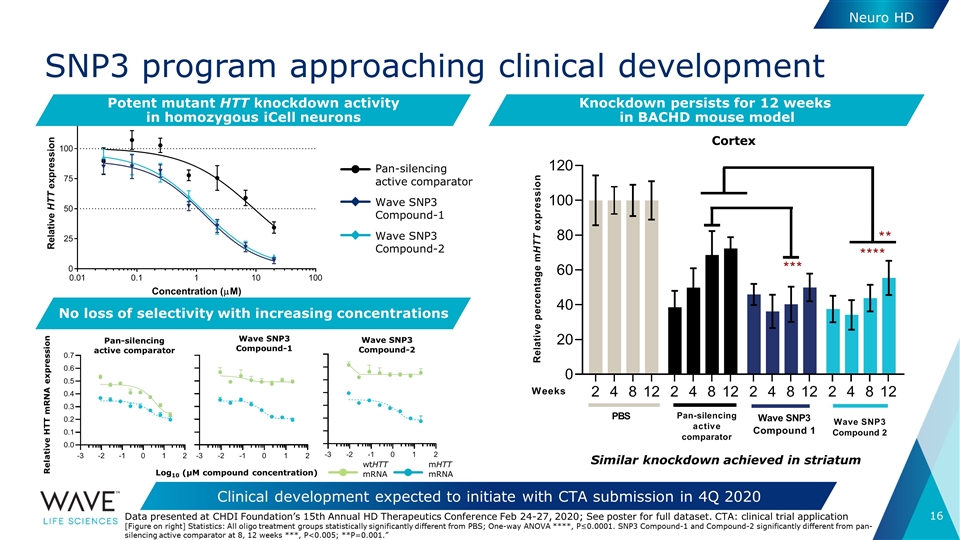
SNP3 program approaching clinical development Knockdown persists for 12 weeks in BACHD mouse model Data presented at CHDI Foundation’s 15th Annual HD Therapeutics Conference Feb 24-27, 2020; See poster for full dataset. CTA: clinical trial application [Figure on right] Statistics: All oligo treatment groups statistically significantly different from PBS; One-way ANOVA ****, P≤0.0001. SNP3 Compound-1 and Compound-2 significantly different from pan-silencing active comparator at 8, 12 weeks ***, P<0.005; **P=0.001.” Clinical development expected to initiate with CTA submission in 4Q 2020 Pan-silencing active comparator Wave SNP3 Compound-1 Wave SNP3 Compound-2 Relative HTT mRNA expression Log10 (µM compound concentration) Pan-silencing active comparator Wave SNP3 Compound-1 Wave SNP3 Compound-2 wtHTT mRNA Cortex Similar knockdown achieved in striatum Potent mutant HTT knockdown activity in homozygous iCell neurons No loss of selectivity with increasing concentrations mHTT mRNA Neuro HD
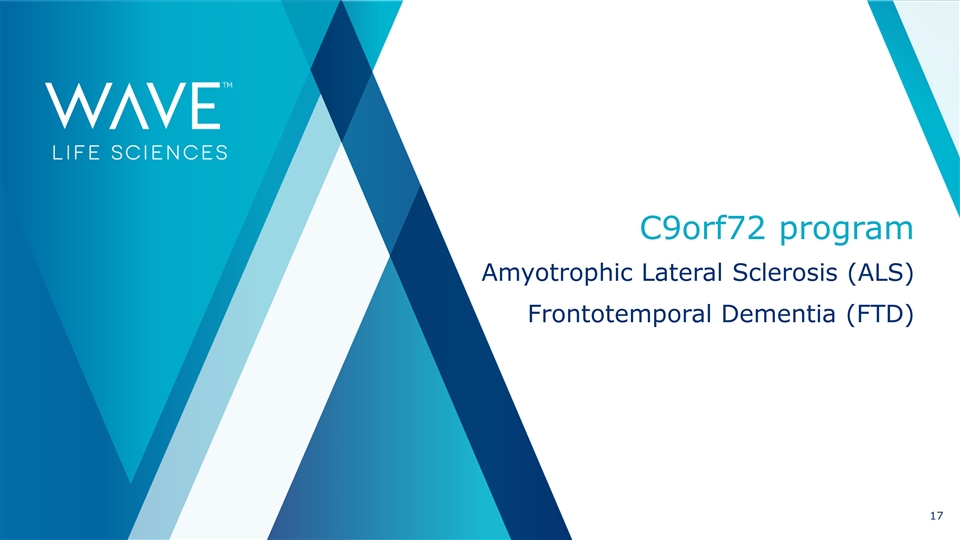
C9orf72 program Amyotrophic Lateral Sclerosis (ALS) Frontotemporal Dementia (FTD)
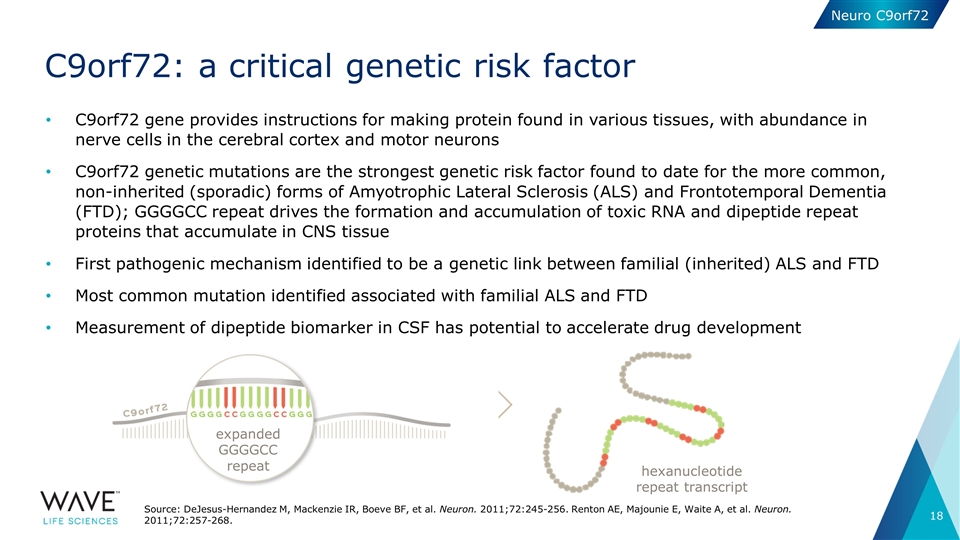
C9orf72: a critical genetic risk factor C9orf72 gene provides instructions for making protein found in various tissues, with abundance in nerve cells in the cerebral cortex and motor neurons C9orf72 genetic mutations are the strongest genetic risk factor found to date for the more common, non-inherited (sporadic) forms of Amyotrophic Lateral Sclerosis (ALS) and Frontotemporal Dementia (FTD); GGGGCC repeat drives the formation and accumulation of toxic RNA and dipeptide repeat proteins that accumulate in CNS tissue First pathogenic mechanism identified to be a genetic link between familial (inherited) ALS and FTD Most common mutation identified associated with familial ALS and FTD Measurement of dipeptide biomarker in CSF has potential to accelerate drug development expanded GGGGCC repeat hexanucleotide repeat transcript Neuro C9orf72 Source: DeJesus-Hernandez M, Mackenzie IR, Boeve BF, et al. Neuron. 2011;72:245-256. Renton AE, Majounie E, Waite A, et al. Neuron. 2011;72:257-268.
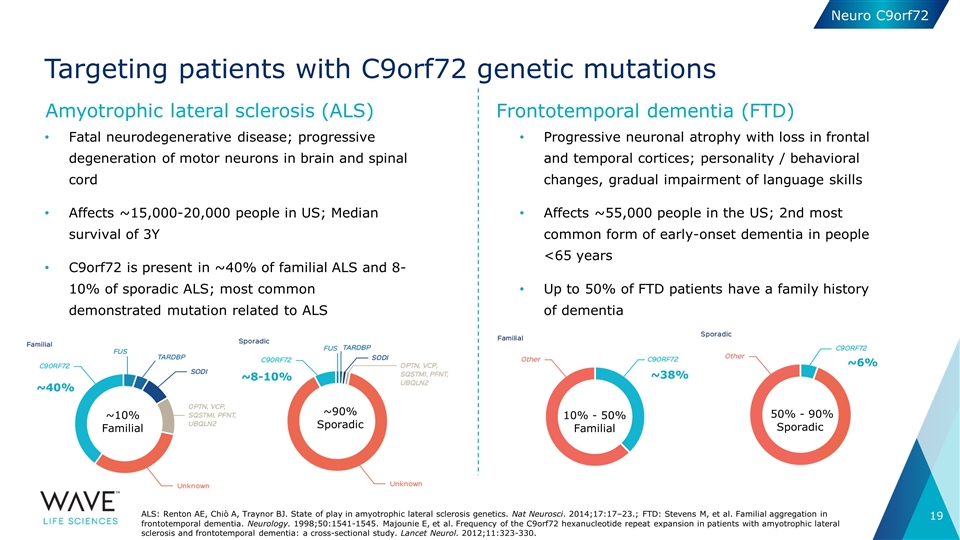
Targeting patients with C9orf72 genetic mutations Fatal neurodegenerative disease; progressive degeneration of motor neurons in brain and spinal cord Affects ~15,000-20,000 people in US; Median survival of 3Y C9orf72 is present in ~40% of familial ALS and 8-10% of sporadic ALS; most common demonstrated mutation related to ALS ALS: Renton AE, Chiò A, Traynor BJ. State of play in amyotrophic lateral sclerosis genetics. Nat Neurosci. 2014;17:17–23.; FTD: Stevens M, et al. Familial aggregation in frontotemporal dementia. Neurology. 1998;50:1541-1545. Majounie E, et al. Frequency of the C9orf72 hexanucleotide repeat expansion in patients with amyotrophic lateral sclerosis and frontotemporal dementia: a cross-sectional study. Lancet Neurol. 2012;11:323-330. ~8-10% ~40% ~10% Familial ~90% Sporadic Progressive neuronal atrophy with loss in frontal and temporal cortices; personality / behavioral changes, gradual impairment of language skills Affects ~55,000 people in the US; 2nd most common form of early-onset dementia in people <65 years Up to 50% of FTD patients have a family history of dementia ~38% 10% - 50% Familial ~6% 50% - 90% Sporadic Amyotrophic lateral sclerosis (ALS) Frontotemporal dementia (FTD) Neuro C9orf72
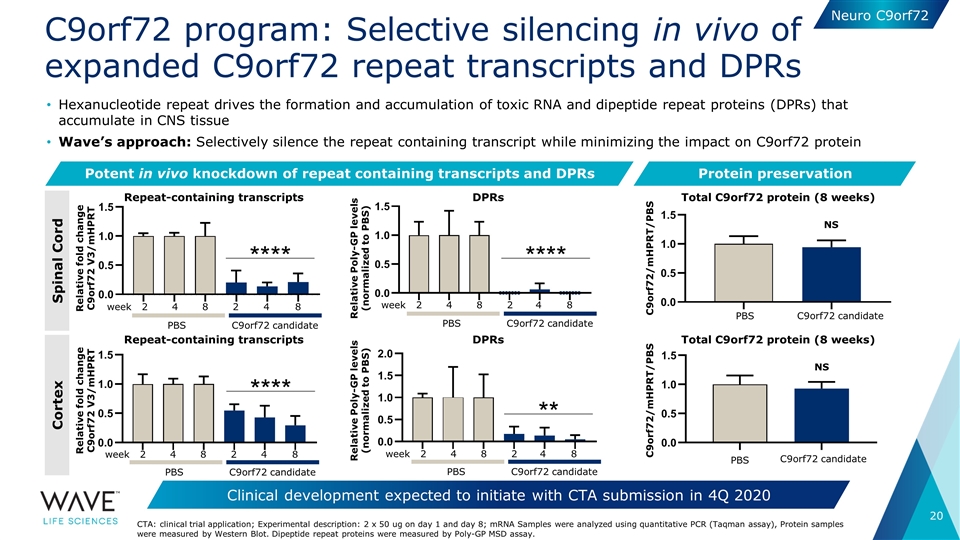
2 4 8 week 2 4 8 Repeat-containing transcripts C9orf72 candidate PBS Relative fold change C9orf72 V3/mHPRT 2 4 8 week 2 4 8 C9orf72 program: Selective silencing in vivo of expanded C9orf72 repeat transcripts and DPRs Clinical development expected to initiate with CTA submission in 4Q 2020 Hexanucleotide repeat drives the formation and accumulation of toxic RNA and dipeptide repeat proteins (DPRs) that accumulate in CNS tissue Wave’s approach: Selectively silence the repeat containing transcript while minimizing the impact on C9orf72 protein Potent in vivo knockdown of repeat containing transcripts and DPRs Protein preservation Spinal Cord Cortex Repeat-containing transcripts C9orf72 candidate PBS Relative fold change C9orf72 V3/mHPRT DPRs C9orf72 candidate PBS C9orf72 candidate C9orf72 candidate Relative Poly-GP levels (normalized to PBS) Total C9orf72 protein (8 weeks) C9orf72/mHPRT/PBS NS DPRs C9orf72 candidate PBS PBS PBS Relative Poly-GP levels (normalized to PBS) Total C9orf72 protein (8 weeks) C9orf72/mHPRT/PBS NS CTA: clinical trial application; Experimental description: 2 x 50 ug on day 1 and day 8; mRNA Samples were analyzed using quantitative PCR (Taqman assay), Protein samples were measured by Western Blot. Dipeptide repeat proteins were measured by Poly-GP MSD assay. 2 4 8 week 2 4 8 2 4 8 week 2 4 8 Neuro C9orf72
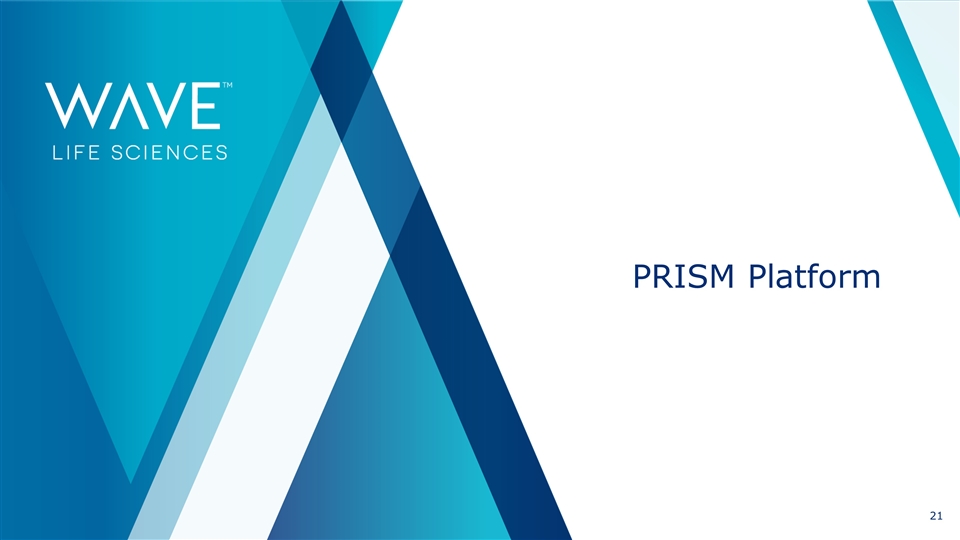
PRISM Platform
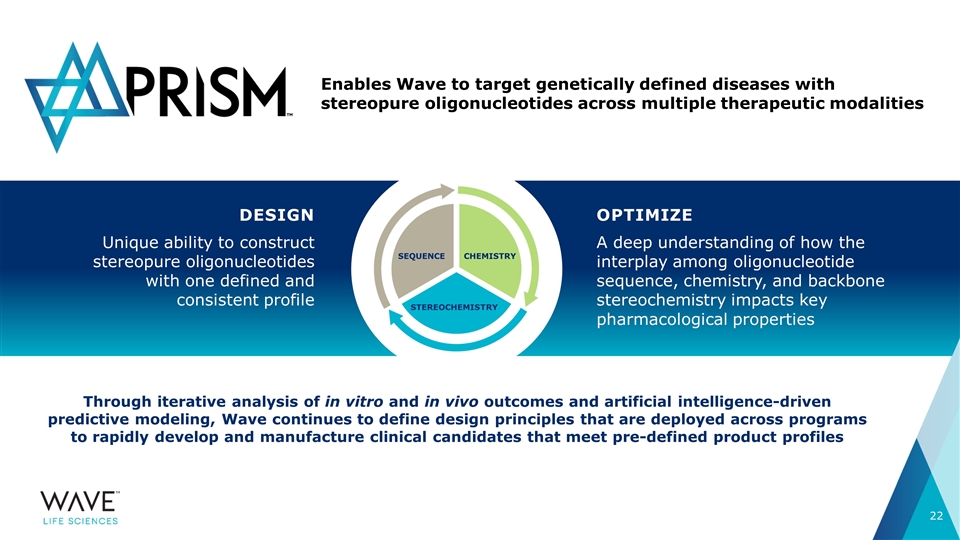
Through iterative analysis of in vitro and in vivo outcomes and artificial intelligence-driven predictive modeling, Wave continues to define design principles that are deployed across programs to rapidly develop and manufacture clinical candidates that meet pre-defined product profiles DESIGN Unique ability to construct stereopure oligonucleotides with one defined and consistent profile Enables Wave to target genetically defined diseases with stereopure oligonucleotides across multiple therapeutic modalities OPTIMIZE A deep understanding of how the interplay among oligonucleotide sequence, chemistry, and backbone stereochemistry impacts key pharmacological properties SEQUENCE STEREOCHEMISTRY CHEMISTRY
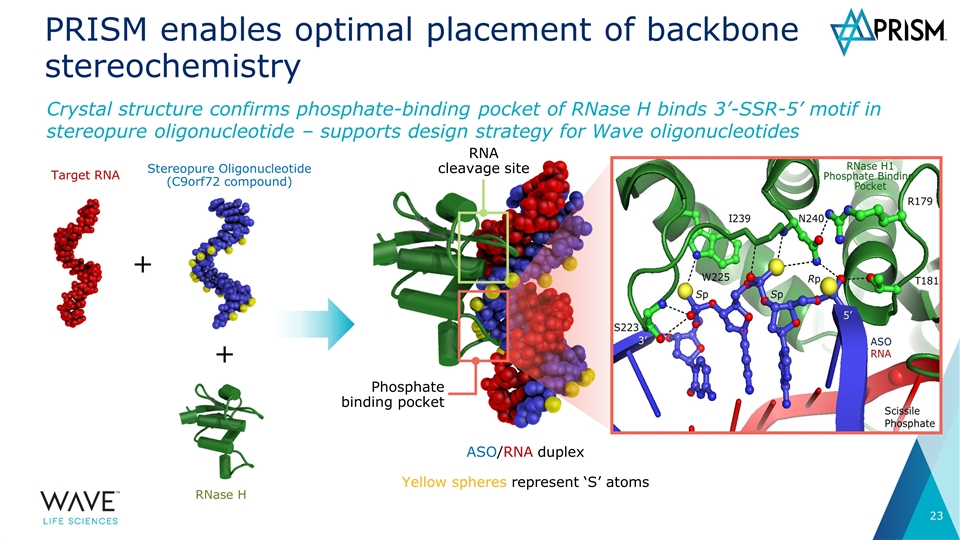
PRISM enables optimal placement of backbone stereochemistry Crystal structure confirms phosphate-binding pocket of RNase H binds 3’-SSR-5’ motif in stereopure oligonucleotide – supports design strategy for Wave oligonucleotides ASO/RNA duplex Yellow spheres represent ‘S’ atoms Phosphate binding pocket RNA cleavage site Target RNA Stereopure Oligonucleotide (C9orf72 compound) RNase H + +
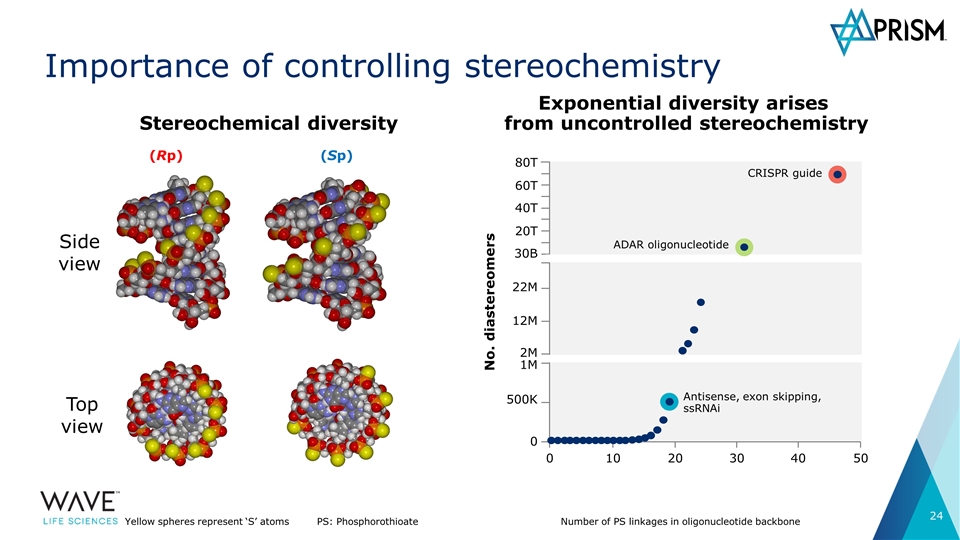
Importance of controlling stereochemistry (Rp) (Sp) Top view Side view Yellow spheres represent ‘S’ atomsPS: Phosphorothioate Number of PS linkages in oligonucleotide backbone No. diastereomers 80T 60T 40T 20T 30B 22M 12M 2M 1M 500K 0 0 10 20 30 40 50 Antisense, exon skipping, ssRNAi ADAR oligonucleotide CRISPR guide Stereochemical diversity Exponential diversity arises from uncontrolled stereochemistry
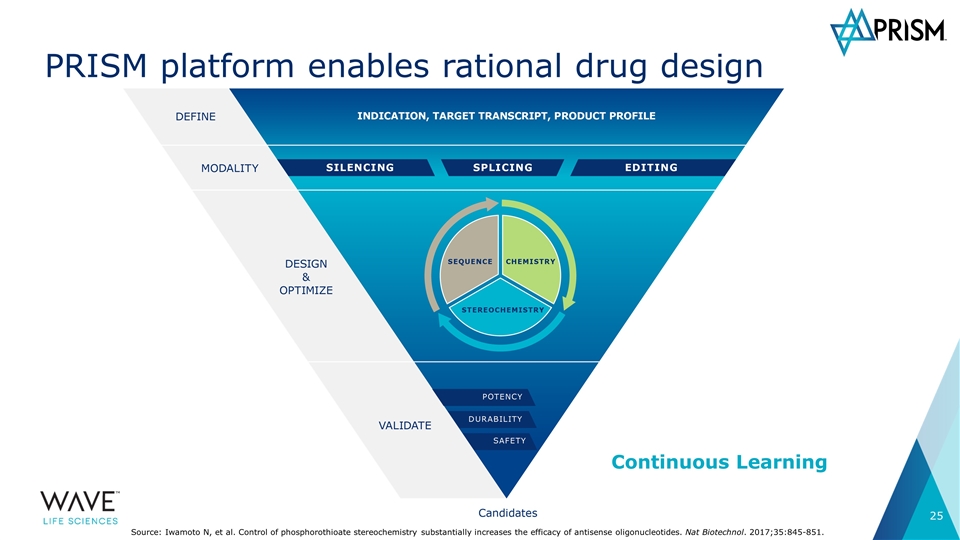
Continuous Learning PRISM platform enables rational drug design Source: Iwamoto N, et al. Control of phosphorothioate stereochemistry substantially increases the efficacy of antisense oligonucleotides. Nat Biotechnol. 2017;35:845-851.
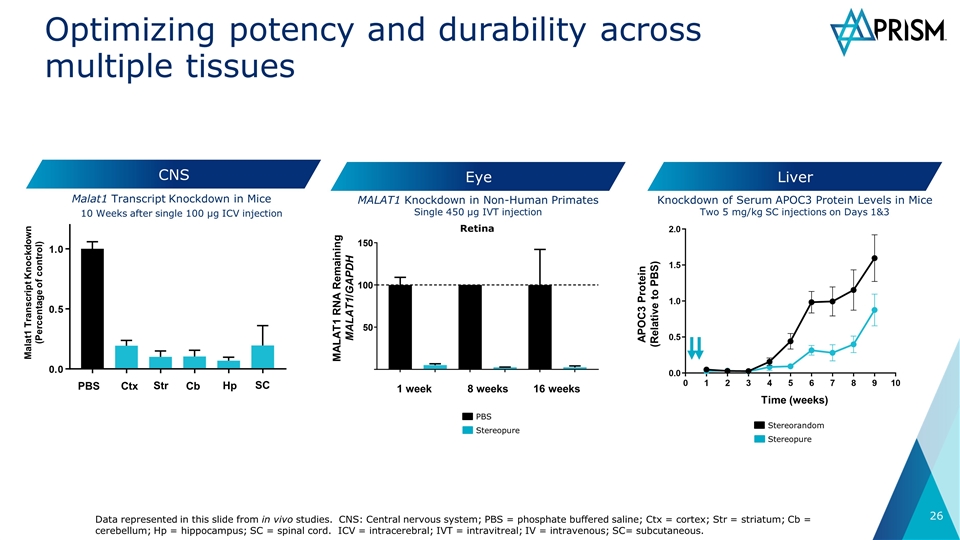
Liver Knockdown of Serum APOC3 Protein Levels in Mice Two 5 mg/kg SC injections on Days 1&3 Stereorandom Stereopure Data represented in this slide from in vivo studies. CNS: Central nervous system; PBS = phosphate buffered saline; Ctx = cortex; Str = striatum; Cb = cerebellum; Hp = hippocampus; SC = spinal cord. ICV = intracerebral; IVT = intravitreal; IV = intravenous; SC= subcutaneous. Optimizing potency and durability across multiple tissues CNS Malat1 Transcript Knockdown in Mice 10 Weeks after single 100 µg ICV injection Malat1 Transcript Knockdown (Percentage of control) PBS Ctx Str Cb Hp SC Eye MALAT1 Knockdown in Non-Human Primates Single 450 µg IVT injection PBS Stereopure Retina MALAT1 RNA Remaining MALAT1/GAPDH 1 week 8 weeks 16 weeks APOC3 Protein (Relative to PBS) Time (weeks)
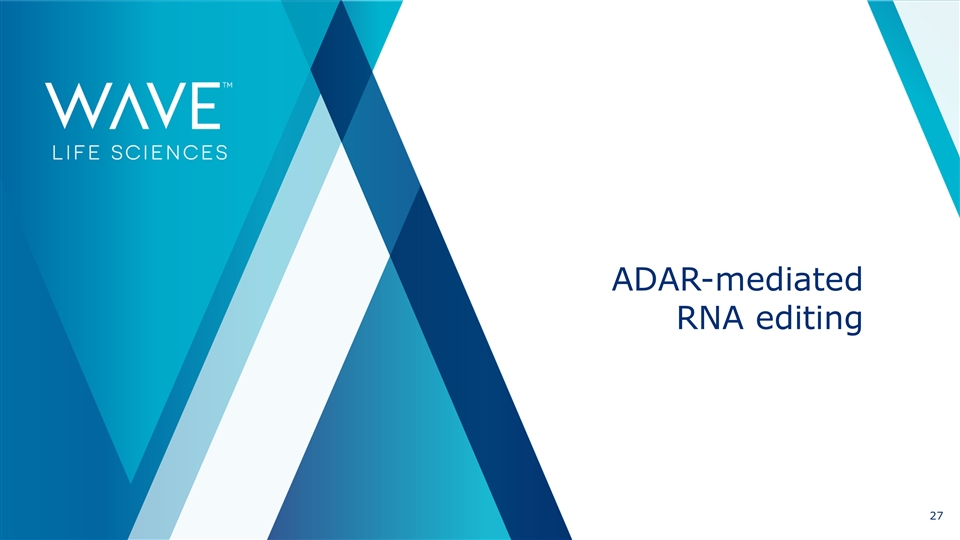
ADAR-mediated RNA editing
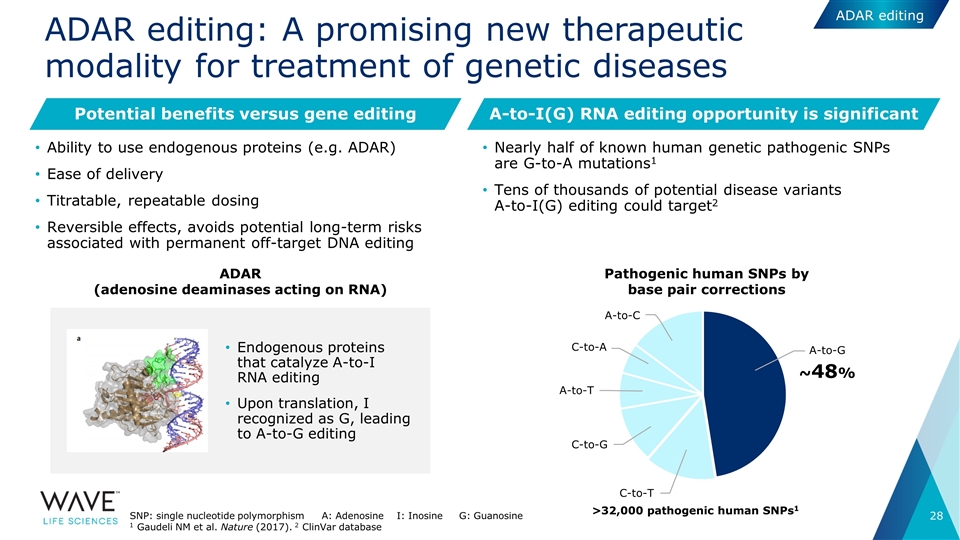
ADAR editing: A promising new therapeutic modality for treatment of genetic diseases Potential benefits versus gene editing A-to-I(G) RNA editing opportunity is significant >32,000 pathogenic human SNPs1 Ability to use endogenous proteins (e.g. ADAR) Ease of delivery Titratable, repeatable dosing Reversible effects, avoids potential long-term risks associated with permanent off-target DNA editing Nearly half of known human genetic pathogenic SNPs are G-to-A mutations1 Tens of thousands of potential disease variants A-to-I(G) editing could target2 SNP: single nucleotide polymorphism A: Adenosine I: Inosine G: Guanosine 1 Gaudeli NM et al. Nature (2017). 2 ClinVar database Pathogenic human SNPs by base pair corrections ADAR (adenosine deaminases acting on RNA) ~48% C-to-T C-to-G A-to-T C-to-A A-to-C A-to-G Endogenous proteins that catalyze A-to-I RNA editing Upon translation, I recognized as G, leading to A-to-G editing ADAR editing
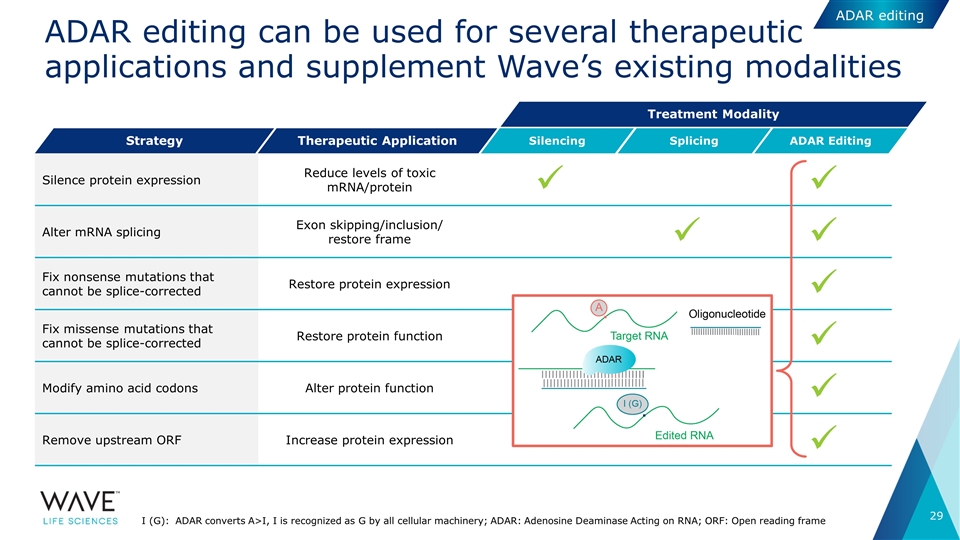
ADAR editing can be used for several therapeutic applications and supplement Wave’s existing modalities Silence protein expression Reduce levels of toxic mRNA/protein ü ü Alter mRNA splicing Exon skipping/inclusion/ restore frame ü ü Fix nonsense mutations that cannot be splice-corrected Restore protein expression ü Fix missense mutations that cannot be splice-corrected Restore protein function ü Modify amino acid codons Alter protein function ü Remove upstream ORF Increase protein expression ü Strategy Therapeutic Application Silencing Splicing ADAR Editing Treatment Modality I (G): ADAR converts A>I, I is recognized as G by all cellular machinery; ADAR: Adenosine Deaminase Acting on RNA; ORF: Open reading frame ADAR editing
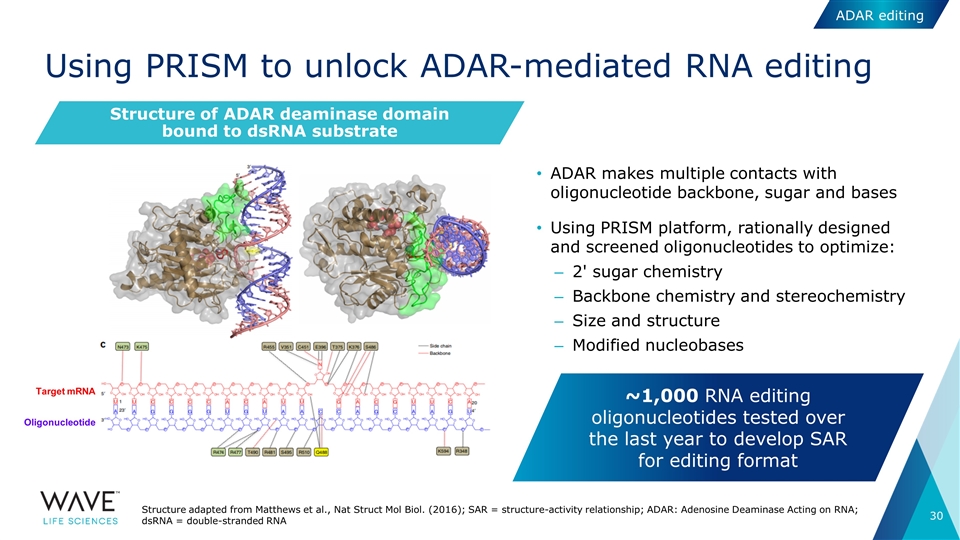
Structure of ADAR deaminase domain bound to dsRNA substrate Using PRISM to unlock ADAR-mediated RNA editing Target mRNA Oligonucleotide ADAR makes multiple contacts with oligonucleotide backbone, sugar and bases Using PRISM platform, rationally designed and screened oligonucleotides to optimize: 2' sugar chemistry Backbone chemistry and stereochemistry Size and structure Modified nucleobases ~1,000 RNA editing oligonucleotides tested over the last year to develop SAR for editing format Structure adapted from Matthews et al., Nat Struct Mol Biol. (2016); SAR = structure-activity relationship; ADAR: Adenosine Deaminase Acting on RNA; dsRNA = double-stranded RNA ADAR editing
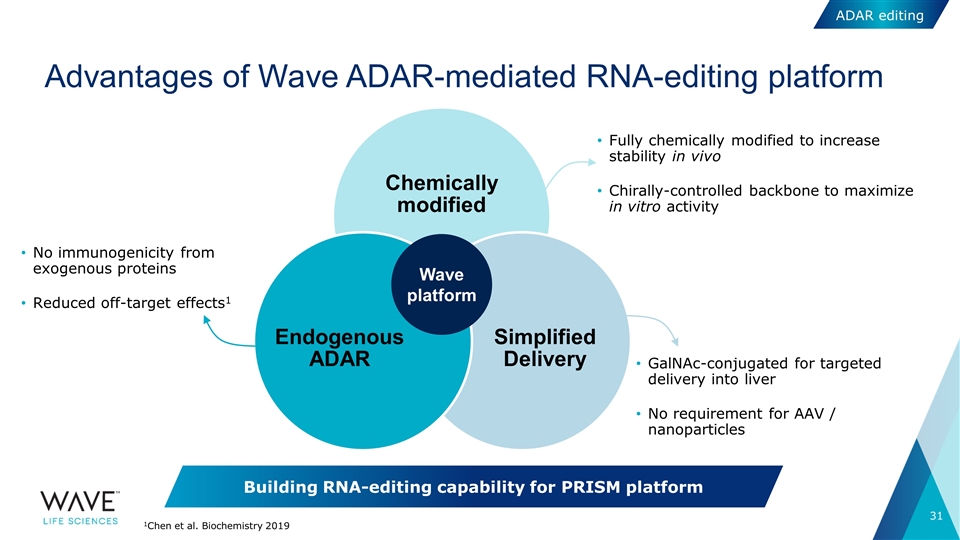
Wave platform Advantages of Wave ADAR-mediated RNA-editing platform Fully chemically modified to increase stability in vivo Chirally-controlled backbone to maximize in vitro activity GalNAc-conjugated for targeted delivery into liver No requirement for AAV / nanoparticles No immunogenicity from exogenous proteins Reduced off-target effects1 1Chen et al. Biochemistry 2019 Building RNA-editing capability for PRISM platform ADAR editing Chemically modified Simplified Delivery Endogenous ADAR
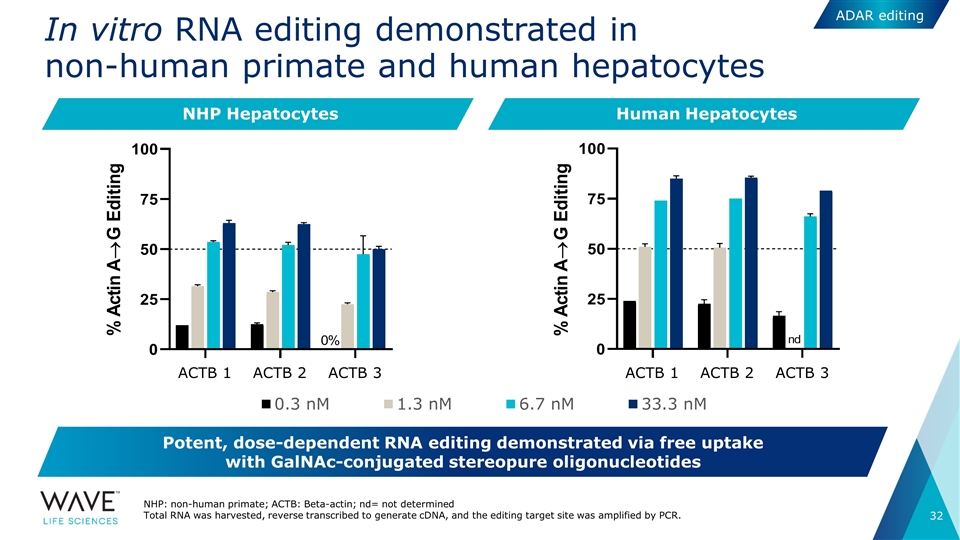
NHP Hepatocytes Human Hepatocytes In vitro RNA editing demonstrated in non-human primate and human hepatocytes NHP: non-human primate; ACTB: Beta-actin; nd= not determined Total RNA was harvested, reverse transcribed to generate cDNA, and the editing target site was amplified by PCR. Potent, dose-dependent RNA editing demonstrated via free uptake with GalNAc-conjugated stereopure oligonucleotides ACTB 1 ACTB 2 ACTB 3 ACTB 1 ACTB 2 ACTB 3 ADAR editing
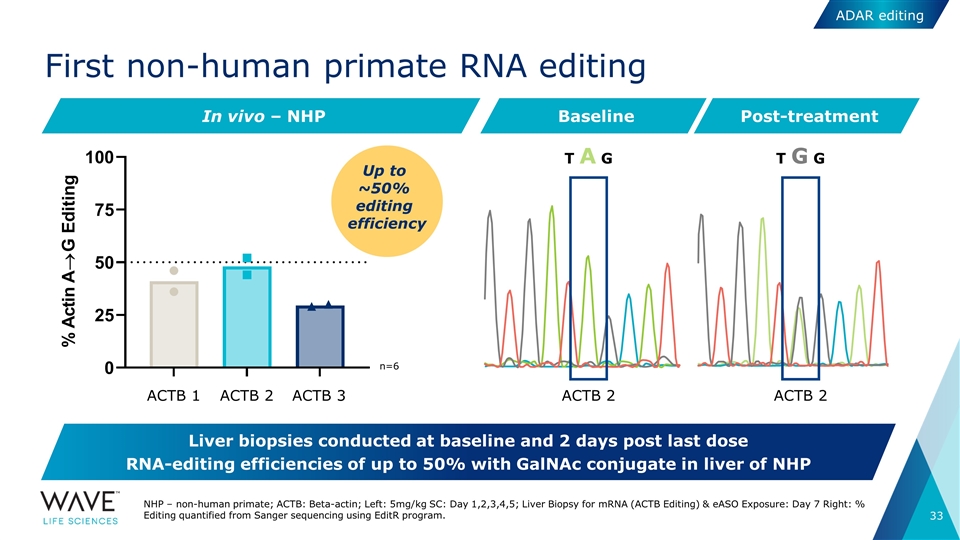
First non-human primate RNA editing NHP – non-human primate; ACTB: Beta-actin; Left: 5mg/kg SC: Day 1,2,3,4,5; Liver Biopsy for mRNA (ACTB Editing) & eASO Exposure: Day 7 Right: % Editing quantified from Sanger sequencing using EditR program. In vivo – NHP Liver biopsies conducted at baseline and 2 days post last dose RNA-editing efficiencies of up to 50% with GalNAc conjugate in liver of NHP Baseline Post-treatment ACTB 1 ACTB 2 ACTB 3 Up to ~50% editing efficiency T A G ACTB 2 T G G ACTB 2 n=6 ADAR editing
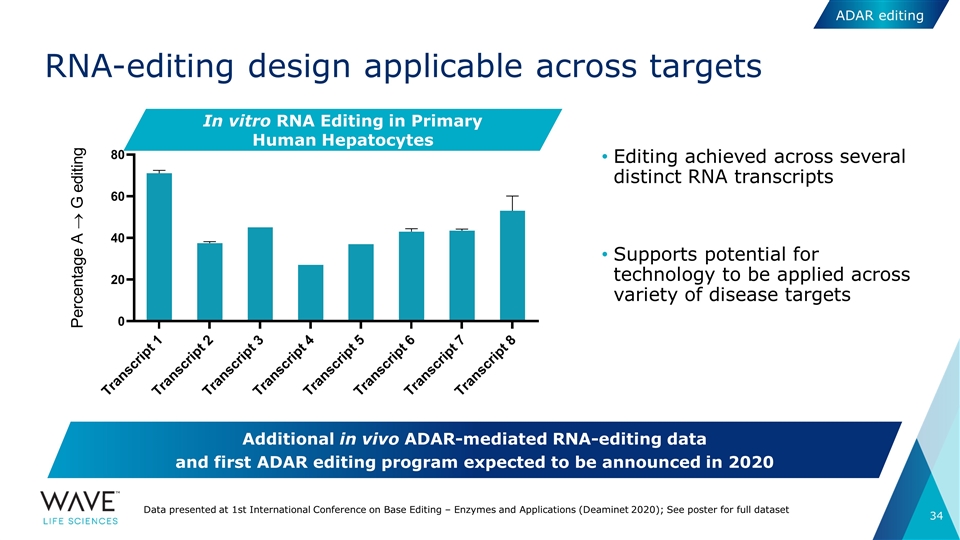
RNA-editing design applicable across targets Data presented at 1st International Conference on Base Editing – Enzymes and Applications (Deaminet 2020); See poster for full dataset Editing achieved across several distinct RNA transcripts Supports potential for technology to be applied across variety of disease targets Additional in vivo ADAR-mediated RNA-editing data and first ADAR editing program expected to be announced in 2020 In vitro RNA Editing in Primary Human Hepatocytes ADAR editing

Ophthalmology
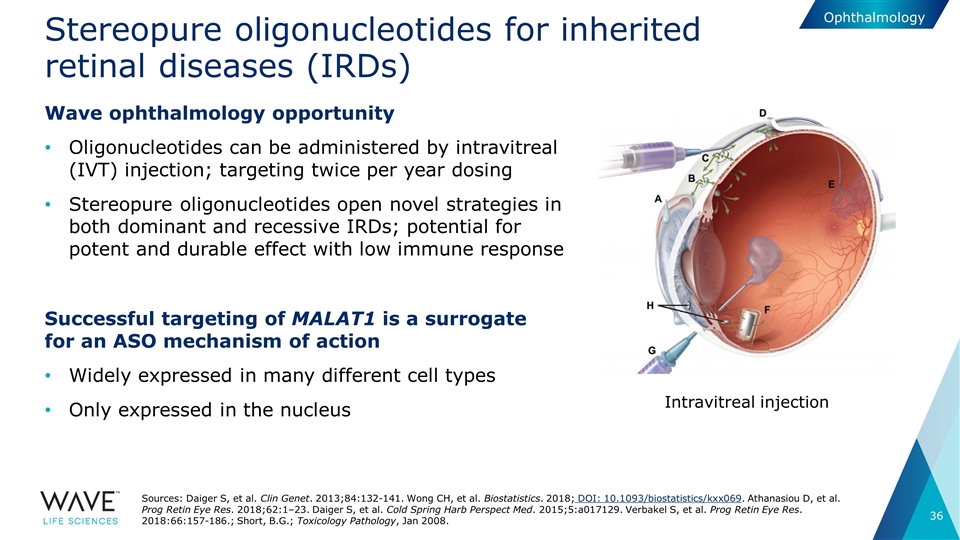
Stereopure oligonucleotides for inherited retinal diseases (IRDs) Wave ophthalmology opportunity Oligonucleotides can be administered by intravitreal (IVT) injection; targeting twice per year dosing Stereopure oligonucleotides open novel strategies in both dominant and recessive IRDs; potential for potent and durable effect with low immune response Successful targeting of MALAT1 is a surrogate for an ASO mechanism of action Widely expressed in many different cell types Only expressed in the nucleus Intravitreal injection Sources: Daiger S, et al. Clin Genet. 2013;84:132-141. Wong CH, et al. Biostatistics. 2018; DOI: 10.1093/biostatistics/kxx069. Athanasiou D, et al. Prog Retin Eye Res. 2018;62:1–23. Daiger S, et al. Cold Spring Harb Perspect Med. 2015;5:a017129. Verbakel S, et al. Prog Retin Eye Res. 2018:66:157-186.; Short, B.G.; Toxicology Pathology, Jan 2008. Ophthalmology
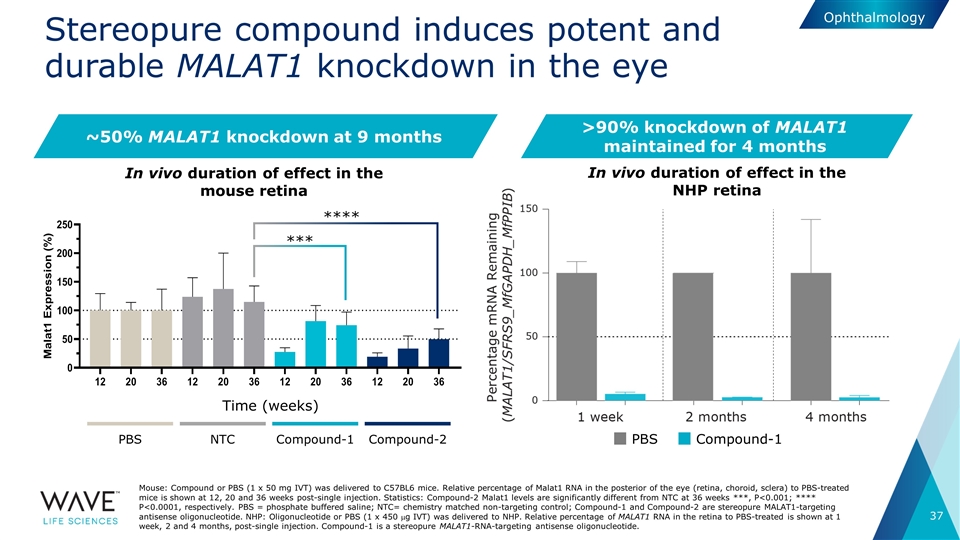
Stereopure compound induces potent and durable MALAT1 knockdown in the eye ~50% MALAT1 knockdown at 9 months Mouse: Compound or PBS (1 x 50 mg IVT) was delivered to C57BL6 mice. Relative percentage of Malat1 RNA in the posterior of the eye (retina, choroid, sclera) to PBS-treated mice is shown at 12, 20 and 36 weeks post-single injection. Statistics: Compound-2 Malat1 levels are significantly different from NTC at 36 weeks ***, P<0.001; **** P<0.0001, respectively. PBS = phosphate buffered saline; NTC= chemistry matched non-targeting control; Compound-1 and Compound-2 are stereopure MALAT1-targeting antisense oligonucleotide. NHP: Oligonucleotide or PBS (1 x 450 mg IVT) was delivered to NHP. Relative percentage of MALAT1 RNA in the retina to PBS-treated is shown at 1 week, 2 and 4 months, post-single injection. Compound-1 is a stereopure MALAT1-RNA-targeting antisense oligonucleotide. PBS NTC Compound-1 Compound-2 Time (weeks) **** *** Ophthalmology In vivo duration of effect in the NHP retina In vivo duration of effect in the mouse retina PBS Compound-1 >90% knockdown of MALAT1 maintained for 4 months
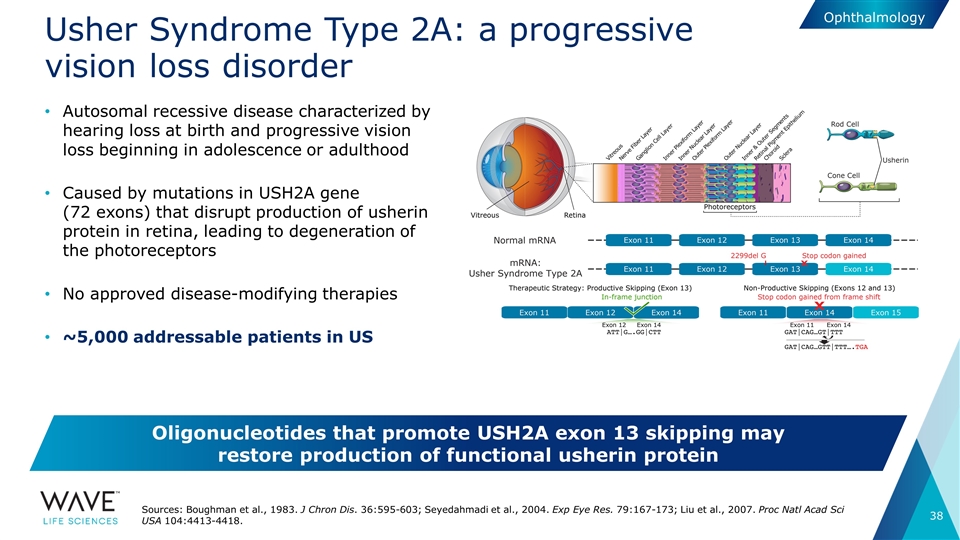
Usher Syndrome Type 2A: a progressive vision loss disorder Autosomal recessive disease characterized by hearing loss at birth and progressive vision loss beginning in adolescence or adulthood Caused by mutations in USH2A gene (72 exons) that disrupt production of usherin protein in retina, leading to degeneration of the photoreceptors No approved disease-modifying therapies ~5,000 addressable patients in US Sources: Boughman et al., 1983. J Chron Dis. 36:595-603; Seyedahmadi et al., 2004. Exp Eye Res. 79:167-173; Liu et al., 2007. Proc Natl Acad Sci USA 104:4413-4418. Oligonucleotides that promote USH2A exon 13 skipping may restore production of functional usherin protein Ophthalmology
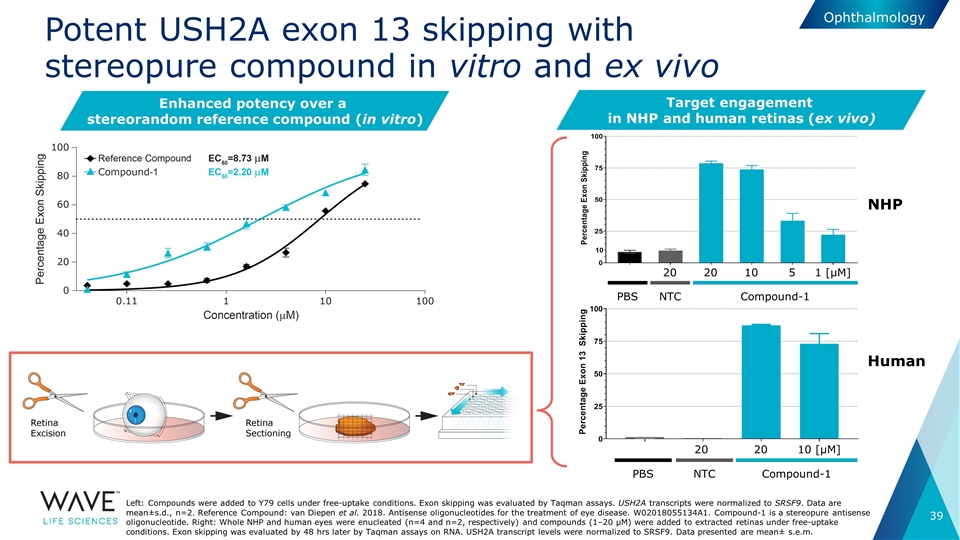
Potent USH2A exon 13 skipping with stereopure compound in vitro and ex vivo Left: Compounds were added to Y79 cells under free-uptake conditions. Exon skipping was evaluated by Taqman assays. USH2A transcripts were normalized to SRSF9. Data are mean±s.d., n=2. Reference Compound: van Diepen et al. 2018. Antisense oligonucleotides for the treatment of eye disease. W02018055134A1. Compound-1 is a stereopure antisense oligonucleotide. Right: Whole NHP and human eyes were enucleated (n=4 and n=2, respectively) and compounds (1–20 µM) were added to extracted retinas under free-uptake conditions. Exon skipping was evaluated by 48 hrs later by Taqman assays on RNA. USH2A transcript levels were normalized to SRSF9. Data presented are mean± s.e.m. Enhanced potency over a stereorandom reference compound (in vitro) Ophthalmology Target engagement in NHP and human retinas (ex vivo) PBS NTC Compound-1 20 20 10 5 1 [µM] PBS NTC Compound-1 20 20 10 [µM] NHP Human
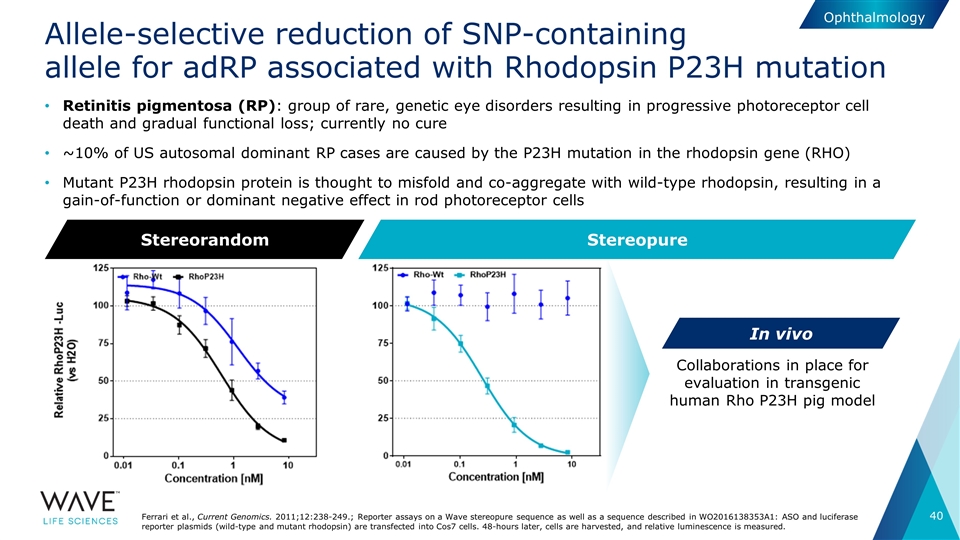
Allele-selective reduction of SNP-containing allele for adRP associated with Rhodopsin P23H mutation Ferrari et al., Current Genomics. 2011;12:238-249.; Reporter assays on a Wave stereopure sequence as well as a sequence described in WO2016138353A1: ASO and luciferase reporter plasmids (wild-type and mutant rhodopsin) are transfected into Cos7 cells. 48-hours later, cells are harvested, and relative luminescence is measured. Stereorandom Stereopure Collaborations in place for evaluation in transgenic human Rho P23H pig model In vivo Ophthalmology Retinitis pigmentosa (RP): group of rare, genetic eye disorders resulting in progressive photoreceptor cell death and gradual functional loss; currently no cure ~10% of US autosomal dominant RP cases are caused by the P23H mutation in the rhodopsin gene (RHO) Mutant P23H rhodopsin protein is thought to misfold and co-aggregate with wild-type rhodopsin, resulting in a gain-of-function or dominant negative effect in rod photoreceptor cells
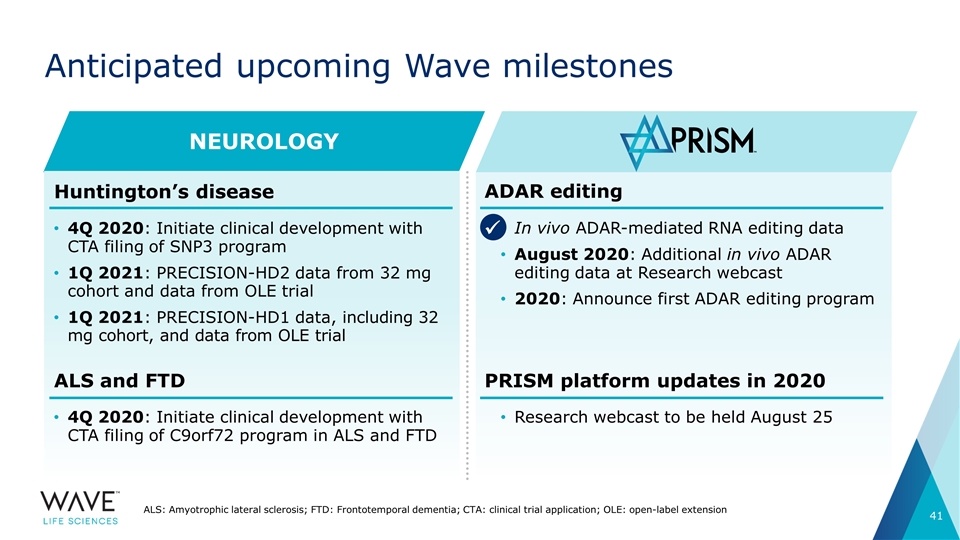
Anticipated upcoming Wave milestones NEUROLOGY Huntington’s disease 4Q 2020: Initiate clinical development with CTA filing of SNP3 program 1Q 2021: PRECISION-HD2 data from 32 mg cohort and data from OLE trial 1Q 2021: PRECISION-HD1 data, including 32 mg cohort, and data from OLE trial ALS and FTD 4Q 2020: Initiate clinical development with CTA filing of C9orf72 program in ALS and FTD ADAR editing In vivo ADAR-mediated RNA editing data August 2020: Additional in vivo ADAR editing data at Research webcast 2020: Announce first ADAR editing program PRISM platform updates in 2020 Research webcast to be held August 25 ü ALS: Amyotrophic lateral sclerosis; FTD: Frontotemporal dementia; CTA: clinical trial application; OLE: open-label extension

Realizing a brighter future for people affected by genetic diseases For more information: Kate Rausch, Investor Relations krausch@wavelifesci.com 617.949.4827









































